Assessment of Catalyst Selectivity in Carbon-Nanotube Silylesterification
Abstract
Featured Application
Abstract
1. Introduction
2. Materials and Methods
2.1. Diazonium-Mediated Modification
2.2. Silylesterification
2.3. Determination of Hansen Solubility Parameters
3. Results
3.1. Diazonium-Mediated Modification
3.2. Silylesterification
4. Conclusions
Author Contributions
Funding
Acknowledgments
Conflicts of Interest
References
- Iijima, S. Helical microtubules of graphitic carbon. Nature 1991, 354, 56–58. [Google Scholar] [CrossRef]
- Kumar, S.; Rani, R.; Dilbaghi, N.; Tankeshwar, K.; Kim, K.-H. Carbon nanotubes: A novel material for multifaceted applications in human healthcare. Chem. Soc. Rev. 2017, 46, 158–196. [Google Scholar] [CrossRef] [PubMed]
- Karousis, N.; Tagmatarchis, N.; Tasis, D. Current progress on the chemical modification of carbon nanotubes. Chem. Rev. 2010, 110, 5366–5397. [Google Scholar] [CrossRef] [PubMed]
- Suman, L.; Vikas. Dispersibility of carbon nanotubes in organic solvents: Do we really have predictive models? J. Nanoparticle Res. 2017, 19, 211. [Google Scholar] [CrossRef]
- Farghali, A.; Tawab, H.A.A.; Moaty, S.A.A.; Khaled, R. Functionalization of acidified multi-walled carbon nanotubes for removal of heavy metals in aqueous solutions. J. Nanostructure Chem. 2017, 7, 101–111. [Google Scholar] [CrossRef]
- Mohamed, A.A.; Salmi, Z.; Dahoumane, S.A.; Mekki, A.; Carbonnier, B.; Chehimi, M.M. Functionalization of nanomaterials with aryldiazonium salts. Adv. Colloid Interface Sci. 2015, 225, 16–36. [Google Scholar] [CrossRef]
- Bhakta, A.K.; Detriche, S.; Kumari, S.; Hussain, S.; Martis, P.; Mascarenhas, R.J.; Delhalle, J.; Mekhalif, Z. Multi-wall Carbon Nanotubes Decorated with Bismuth Oxide Nanocrystals Using Infrared Irradiation and Diazonium Chemistry. J. Inorg. Organomet. Polym. Mater. 2018, 28, 1402–1413. [Google Scholar] [CrossRef]
- Kharissova, O.V.; Kharisov, B.I.; Leija, G.H.M. Functionalization of SWCNTs with amine derivatives and comparative solubilization studies. J. Mater. Sci. 2018, 53, 466–478. [Google Scholar] [CrossRef]
- Musayeva, N.; Orujov, T.; Hasanov, R.; Sultanov, C.; Ferrari, C.; Frigeri, C.; Trevisi, G.; Beretta, S.; Bosi, M.; Verucchi, R.; et al. Growth and functionalization of carbon nanotubes for nitroaromatic explosive detection. Mater. Today Proc. 2019. [Google Scholar] [CrossRef]
- Modugno, G.; Ksar, F.; Battigelli, A.; Russier, J.; Lonchambon, P.; Eleto Da Silva, E.; Ménard-Moyon, C.; Soula, B.; Galibert, A.M.; Pinault, M.; et al. A comparative study on the enzymatic biodegradability of covalently functionalized double- and multi-walled carbon nanotubes. Carbon 2016, 100, 367–374. [Google Scholar] [CrossRef]
- Seffer, J.-F.; Detriche, S.; Nagy, J.B.; Delhalle, J.; Mekhalif, Z. Silylesterification of oxidized multi-wall carbon nanotubes by catalyzed dehydrogenative cross-coupling between carboxylic and hydrosilane functions. Appl. Surf. Sci. 2014, 305, 301–308. [Google Scholar] [CrossRef]
- Karabörk, M.; Fattah, B.S. Synthesis, characterization and application in the water purification of the multi-walled carbon nanotubes hybrid material. Inorg. Nano-Metal Chem. 2019, 48, 312–322. [Google Scholar] [CrossRef]
- Shanmugharaj, A.M.; Ryu, S.H. Influence of aminosilane-functionalized carbon nanotubes on the rheometric, mechanical, electrical and thermal degradation properties of epoxidized natural rubber nanocomposites. Polym. Int. 2013, 62, 1433–1441. [Google Scholar] [CrossRef]
- Vennerberg, D.; Hall, R.; Kessler, M.R. Supercritical carbon dioxide-assisted silanization of multi-walled carbon nanotubes and their effect on the thermo-mechanical properties of epoxy nanocomposites. Polymer (Guildf) 2014, 55, 4156–4163. [Google Scholar] [CrossRef]
- Bhakta, A.K.; Detriche, S.; Martis, P.; Mascarenhas, R.J.; Delhalle, J.; Mekhalif, Z. Decoration of tricarboxylic and monocarboxylic aryl diazonium functionalized multi-wall carbon nanotubes with iron nanoparticles. J. Mater. Sci. 2017, 52, 9648–9660. [Google Scholar] [CrossRef]
- Bhakta, A.K.; Mascarenhas, R.J.; Martis, P.; Delhalle, J.; Mekhalif, Z. Multi-wall carbon nanotubes decorated with barium oxide nanoparticles. Synth. Catal. Open Access 2018, 3, 1–4. [Google Scholar]
- Chehimi, M.M. (Ed.) Aryl Diazonium Salts: New Coupling Agents in Polymer and Surface Science; Wiley-VCH: Weinheim, Germany, 2012; ISBN 978-3-527-32998-4. [Google Scholar]
- Detriche, S.; Nagy, J.B.; Mekhalif, Z.; Delhalle, J. Surface state of carbon nanotubes and Hansen solubility parameters. J. Nanosci. Nanotechnol. 2009, 9, 6015–6025. [Google Scholar] [CrossRef]
- Charles, M.H. Hansen Solubility Parameters: A User’s Handbook; CRC Press: Boca Raton, FL, USA, 2000; ISBN 0849315255. [Google Scholar]
- Detriche, S.; Zorzini, G.; Colomer, J.-F.; Fonseca, A.; Nagy, J.B. Application of the Hansen solubility parameters theory to carbon nanotubes. J. Nanosci. Nanotechnol. 2008, 8, 6082–6092. [Google Scholar] [CrossRef]
- Beamson, G.; Briggs, D. High resolution monochromated X-ray photoelectron spectroscopy of organic polymers : A comparison between solid state data for organic polymers and gas phase data for small molecules. Mol. Phys. An Int. J. Interface Chem. Phys. 1992, 76, 919–936. [Google Scholar] [CrossRef]
- Detriche, S. Chimie de surface des nanotubes de carbone, vers une meilleure dispersion et solubilisation, Ph.D. Thesis, University of Namur, Namur, Belgium, 31 August 2010. [Google Scholar]
- Bhakta, A.K.; Kumari, S.; Hussain, S.; Martis, P.; Mascarenhas, R.J.; Delhalle, J.; Mekhalif, Z. Synthesis and characterization of maghemite nanocrystals decorated multi-wall carbon nanotubes for methylene blue dye removal. J. Mater. Sci. 2019, 54, 200–216. [Google Scholar] [CrossRef]
- Fujita, M.; Hiyama, T. Highly Diastereocontrolled Reduction of Ketones by means of Hydrosilanes. Practical Synthesis of Optically Active 1,2-Diols and 2-Amino Alcohols of Threo or Erythro Configuration. J. Am. Chem. Soc. 1984, 106, 4629–4630. [Google Scholar] [CrossRef]
- Shaikh, N.S.; Enthaler, S.; Junge, K.; Beller, M. Iron-catalyzed enantioselective hydrosilylation of ketones. Angew. Chemie Int. Ed. 2008, 47, 2497–2501. [Google Scholar] [CrossRef] [PubMed]

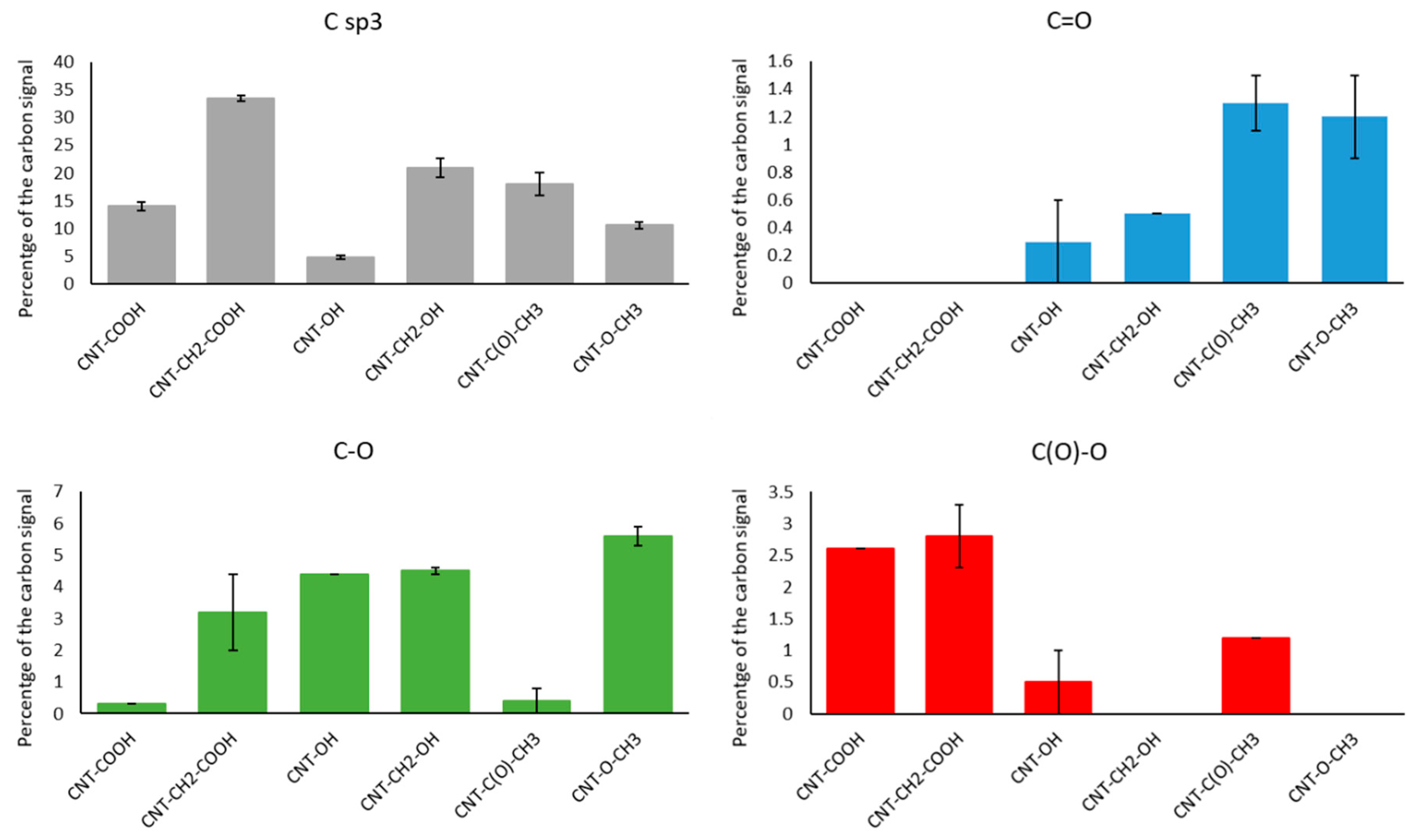

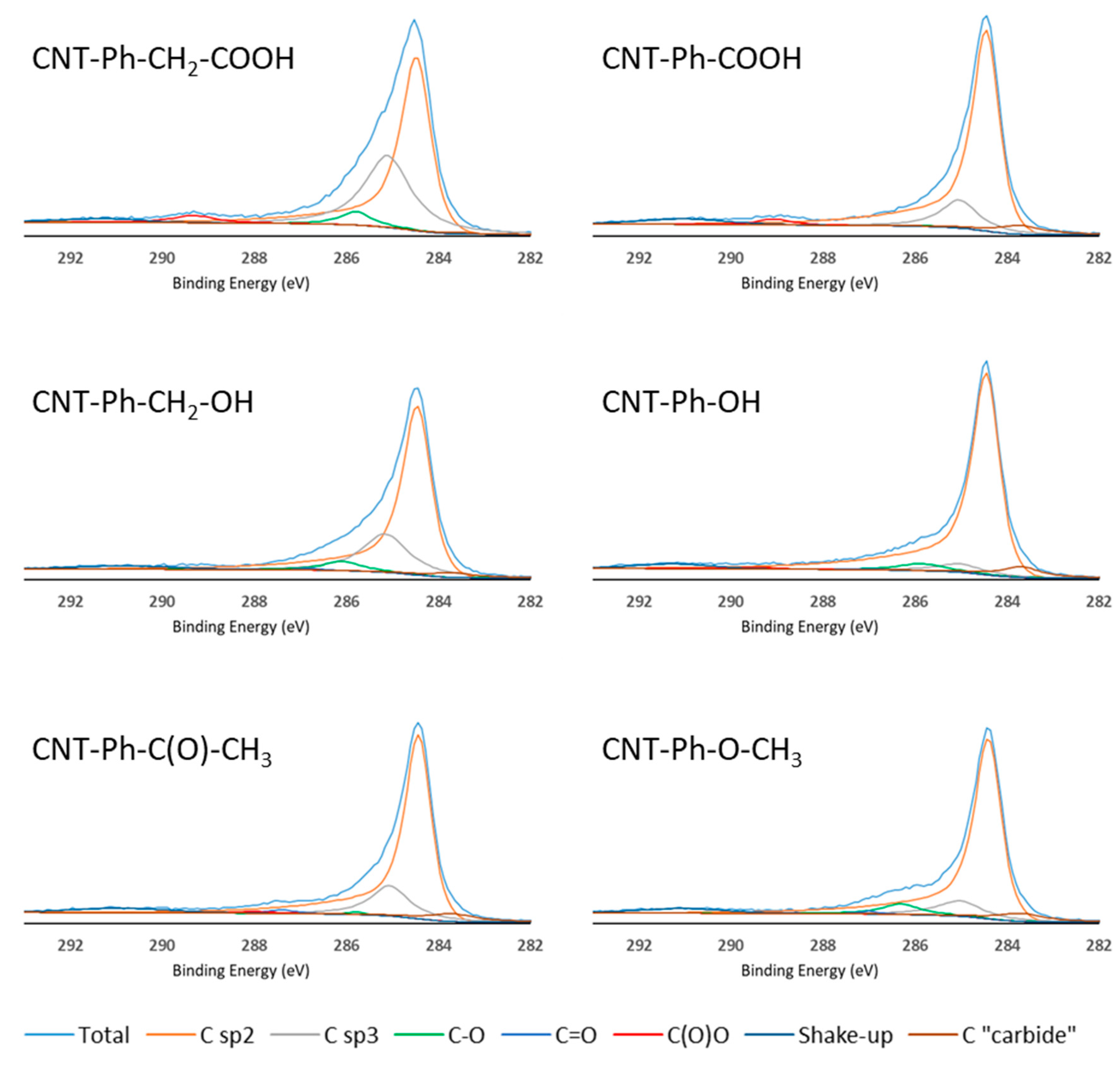

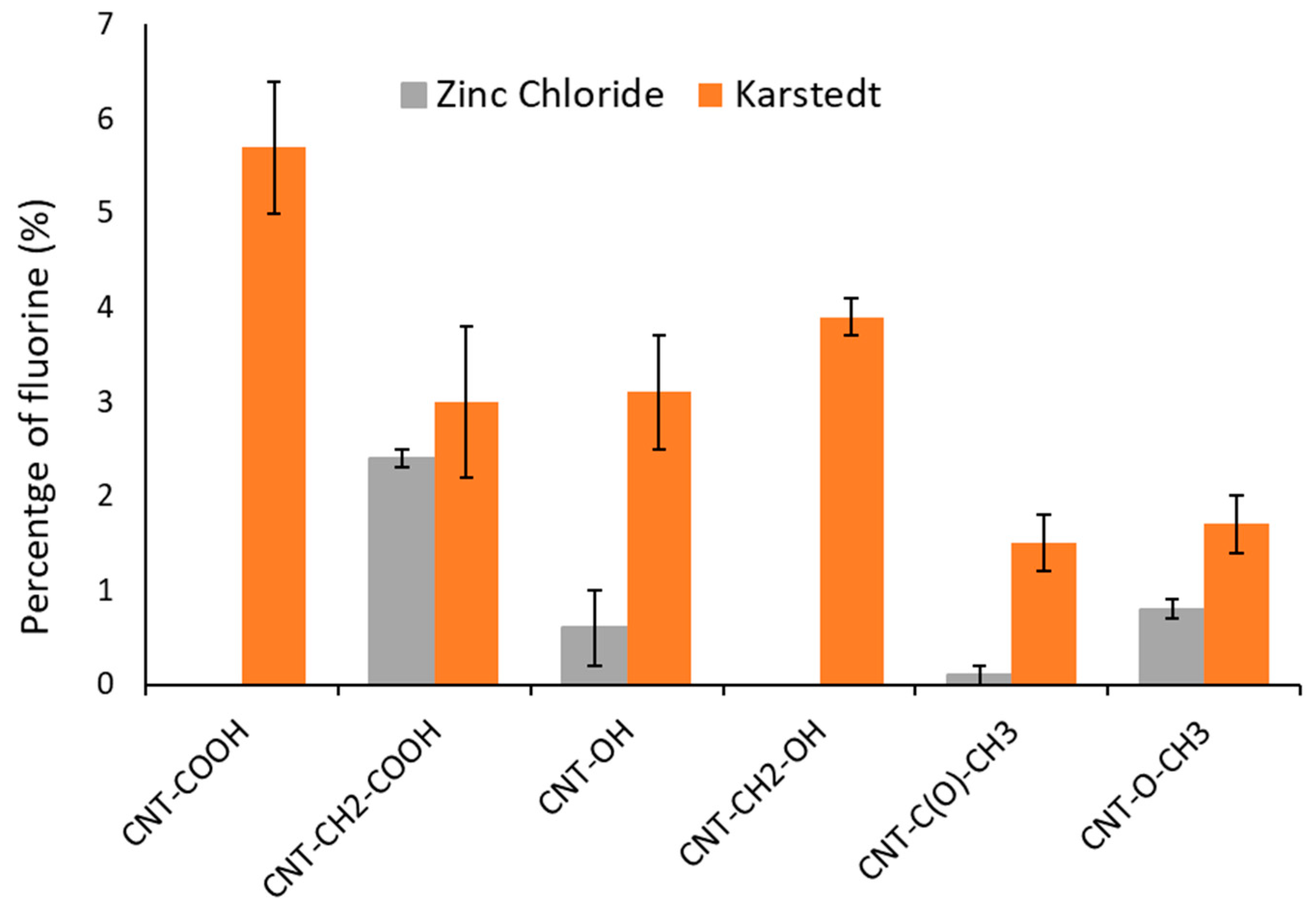
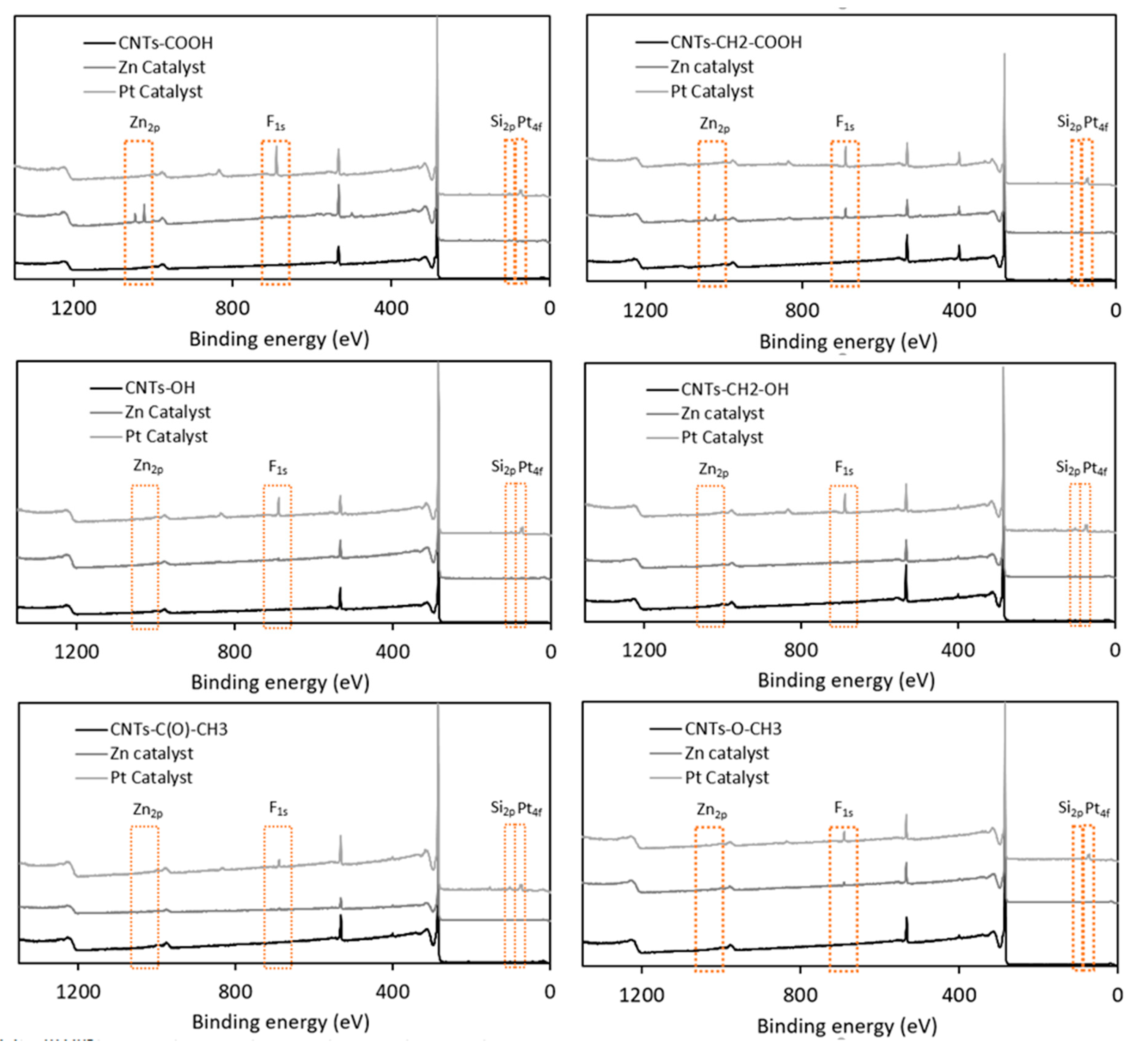
| Sample Name | Aniline Precursor | Targeted Side Chain |
|---|---|---|
| CNT–COOH | 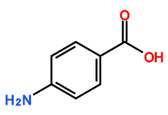 | Carboxylic acid linked to aromatic ring |
| CNT–CH2–COOH |  | Carboxylic acid separated from aromatic ring by methylene group |
| CNT–OH |  | Alcohol linked to aromatic ring |
| CNT–CH2–OH |  | Alcohol group separated from aromatic ring by methylene group |
| CNT–C(O)–CH3 | 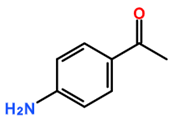 | Ketone linked to aromatic ring |
| CNT–O–CH3 |  | Ether linked to aromatic ring |
| Type | C sp2 (%) | C sp3 (%) | C–O (%) | C=O(%) | C(O)–O (%) | Shake-up (%) | Carbide (%) |
|---|---|---|---|---|---|---|---|
| Energy (eV) | 284.4 ± 0.2 | 285.0 ± 0.2 | 285.8 ± 0.2 | 286.9 ± 0.2 | 289.2 ± 0.2 | 291.0 ± 0.2 | 283.7 ± 0.2 |
| At.% | CNT–COOH | CNT–CH2–COOH | CNT–OH | CNT–CH2–OH | CNT–C(O)–CH3 | CNT–O–CH3 |
|---|---|---|---|---|---|---|
| C | 91.3 ± 0.3 | 85.7 ± 0.2 | 92.6 ± 1.1 | 88.9 ± 0.3 | 93.9 ± 0.2 | 92.4 ± 0.6 |
| N | 0.9 ± 0.4 | 6.4 ± 0.4 | 0.5 ± 0.5 | 2.5 ± 0.1 | 0.1 ± 0.1 | 0.7 ± 0.7 |
| O | 7.7 ± 0.1 | 7.8 ± 0.2 | 6.9 ± 0.6 | 8.6 ± 0.1 | 6.0 ± 0.2 | 6.9 ± 0.1 |
| Sample | δd (MPa1/2) | δp (MPa1/2) | δh (MPa1/2) |
|---|---|---|---|
| CNT–COOH | 17.9 | 14.5 | 7.7 |
| CNT–CH2–COOH | 18.1 | 14.4 | 8.7 |
| CNT–OH | 16.2 | 19.2 | 13.5 |
| CNT–CH2–OH | 21.1 | 8.4 | 14.4 |
| CNT–C(O)–CH3 | 18.1 | 8.6 | 5.3 |
| CNT–O–CH3 | 17.8 | 5.1 | 7.8 |
| Functional Group | Molecule | δd (MPa1/2) | δp (MPa1/2) | δh (MPa1/2) |
|---|---|---|---|---|
| Ketone | Acetone | 15.5 | 10.4 | 7.0 |
| 2-Butanone | 16.0 | 9.0 | 5.1 | |
| Acetophenone | 19.6 | 8.6 | 3.7 | |
| Ether | Diethylether | 14.5 | 2.9 | 5.1 |
| Dipropylether | 15.2 | 3.4 | 4.2 | |
| Anisole | 17.8 | 4.1 | 6.7 |
| Samples | Catalyst | C % | O % | N % | F % | Si % | Pt % | Zn % |
|---|---|---|---|---|---|---|---|---|
| CNT–COOH | ZnCl2 | 91.0 ± 0.4 | 7.3 ± 0.1 | 0.4 ± 0.4 | 0.0 | 0.0 | - | 1.2 ± 0.1 |
| Karstedt’scatalyst | 84.3 ± 0.2 | 6.4 ± 0.3 | 1.4 ± 0.1 | 5.7 ± 0.7 | 1.1 ± 0.1 | 0.7 ± 0.1 | - | |
| CNT–CH2–COOH | ZnCl2 | 87.2 ± 0.6 | 6.2 ± 0.3 | 4.1 ± 0.3 | 2.4 ± 0.1 | 0.5 ± 0.1 | - | 0.6 ± 0.1 |
| Karstedt’scatalyst | 81.9 ± 0.9 | 7.4 ± 0.3 | 6.3 ± 0.4 | 3.0 ± 0.8 | 0.8 ± 0.2 | 0.5 ± 0.1 | - | |
| CNT–OH | ZnCl2 | 94.3 ± 0.7 | 4.8 ± 0.1 | 0.2 ± 0.2 | 0.6 ± 0.4 | 0.0 | - | 0.0 |
| Karstedt’s catalyst | 85.7 ± 3.2 | 8.9 ± 3.3 | 0.4 ± 0.1 | 3.1 ± 0.6 | 1.3 ± 0.1 | 0.5 ± 0.1 | - | |
| CNT–CH2–OH | ZnCl2 | 89.8 ± 1.1 | 7.2 ± 0.5 | 2.2 ± 0.1 | 0.0 | 1.5 ± 0.1 | - | 0.0 |
| Karstedt’s catalyst | 85.5 ± 0.2 | 6.1 ± 0.2 | 2.4 ± 0.2 | 3.9 ± 0.2 | 1.9 ± 0.2 | 0.2 ± 0.2 | - | |
| CNT–C(O)–CH3 | ZnCl2 | 93.6 ± 0.5 | 5.0 ± 0.1 | 1.2 ± 0.4 | 0.1 ± 0.1 | 0.0 | - | 0.0 |
| Karstedt’s catalyst | 89.3 ± 0.5 | 5.6 ± 0.1 | 1.6 ± 0.3 | 1.5 ± 0.3 | 1.8 ± 0.1 | 0.1 ± 0.1 | - | |
| CNT–O–CH3 | ZnCl2 | 91.4 ± 0.5 | 5.6 ± 0.3 | 1.5 ± 0.2 | 0.8 ± 0.1 | 0.6 ± 0.1 | - | 0.0 |
| Karstedt’s catalyst | 91.3 ± 0.5 | 5.3 ± 0.3 | 0.8 ± 0.8 | 1.7 ± 0.3 | 0.9 ± 0.1 | 0.0 | - |
© 2019 by the authors. Licensee MDPI, Basel, Switzerland. This article is an open access article distributed under the terms and conditions of the Creative Commons Attribution (CC BY) license (http://creativecommons.org/licenses/by/4.0/).
Share and Cite
Detriche, S.; Bhakta, A.K.; N’Twali, P.; Delhalle, J.; Mekhalif, Z. Assessment of Catalyst Selectivity in Carbon-Nanotube Silylesterification. Appl. Sci. 2020, 10, 109. https://doi.org/10.3390/app10010109
Detriche S, Bhakta AK, N’Twali P, Delhalle J, Mekhalif Z. Assessment of Catalyst Selectivity in Carbon-Nanotube Silylesterification. Applied Sciences. 2020; 10(1):109. https://doi.org/10.3390/app10010109
Chicago/Turabian StyleDetriche, Simon, Arvind K. Bhakta, Patrick N’Twali, Joseph Delhalle, and Zineb Mekhalif. 2020. "Assessment of Catalyst Selectivity in Carbon-Nanotube Silylesterification" Applied Sciences 10, no. 1: 109. https://doi.org/10.3390/app10010109
APA StyleDetriche, S., Bhakta, A. K., N’Twali, P., Delhalle, J., & Mekhalif, Z. (2020). Assessment of Catalyst Selectivity in Carbon-Nanotube Silylesterification. Applied Sciences, 10(1), 109. https://doi.org/10.3390/app10010109




